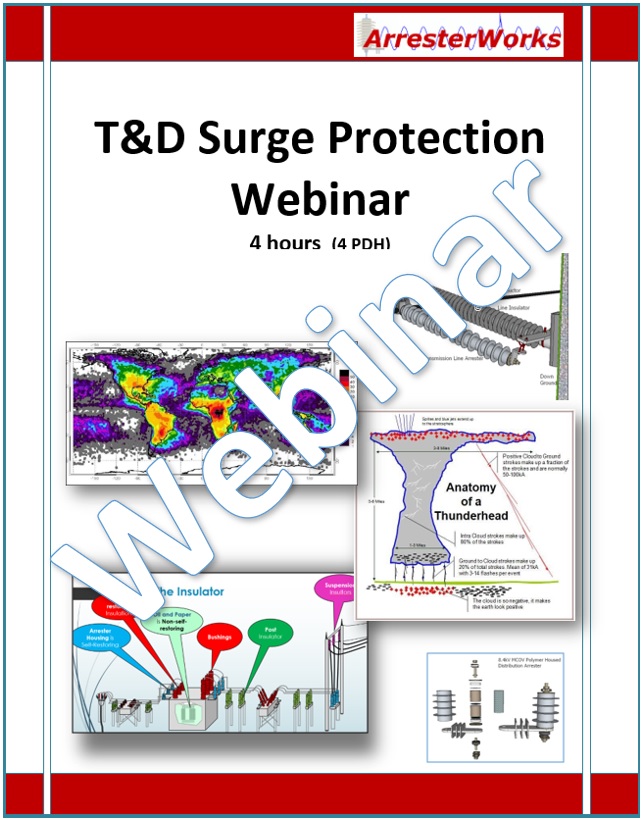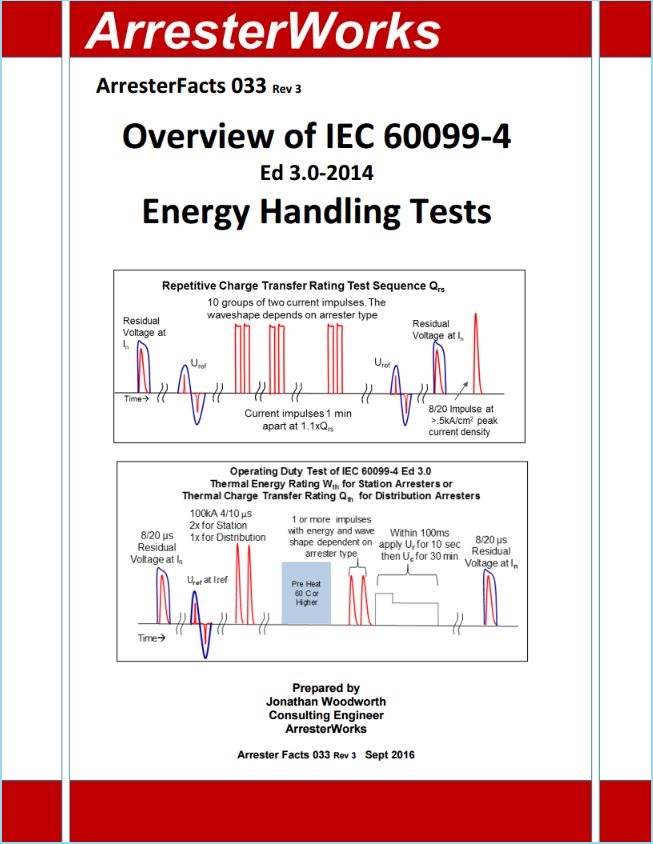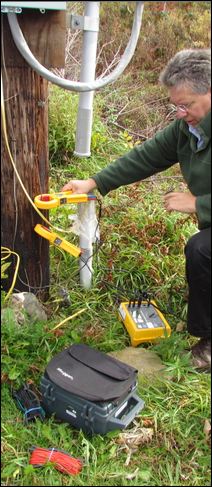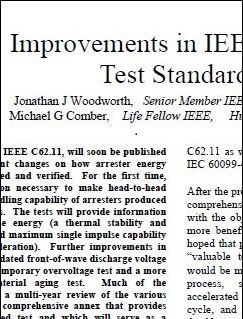|
What's an Arrester? |
|
|
Our Focus |
 |
|
| ArresterWorks is an International Consulting Firm focused on assisting others in improving
power system reliability through design, production and application of arresters to mitigate the effect of lightning
and other transients. See how ArresterWorks can help you if you are a Manufacturer, Educator, or User of Arresters |
||
Topics of Interest
2022
Underbuilt Arrester
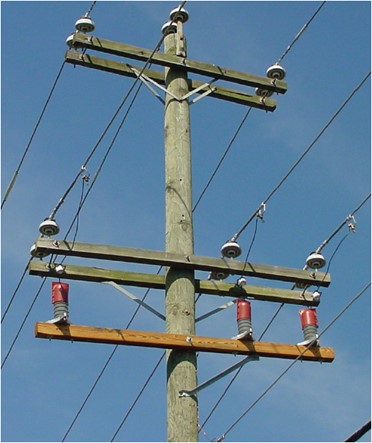
|
|
When two overhead circuits of different voltages exist on the same poles, the possibility exists that contact between the two circuits will occur. If this happens it can result in damage to equipment on the lower voltage circuit. The underbuilt line arrester is a simple method of protecting the lower circuit from a sustained overvoltage event. For more information on this reference ArresterFact 022 in the Knowledge Center. |
Grading Rings not Corona Rings

|
|
Grading rings are often mistaken for corona rings. They indeed look similar and they both are designed to affect the electric field in the near vicinity. However, unlike corona rings, reducing partial discharge is not a function of grading rings. The purpose of grading rings on arresters is to significantly modify the voltage distribution along the vertical axis of the arrester. This voltage distribution allows the arrester to operate without an increase in its temperature near the top of the arrester. The lower temperature level allows the arrester to absorb more energy during a switching surge event. The grading ring in effect increases the energy handling capability of the arrester. |
Old SiC Arresters used as Pedestals

|
|
One of the challenges encountered when upgrading surge protection from the last generation of Silicon Carbide Gapped (SiC) arresters to polymer housed MOV arresters is the difference in height. Polymer housed MOV arresters are sometimes ½ the height of the equivalent rated SiC arrester. In the photo above the installers chose to use the bottom two sections of the old SiC arrester as the pedestal for the shorter polymer housed arrester. The bottom brown section is circa 1950s and the polymer housed arrester is circa 2010. Notice the cable shorting the remaining brown porcelain sections of the SiC arrester to ground. |
Applying Arresters to Create a Shielded System

|
|
An underutilized application of distribution arresters is the use on vertical configurations to double duty the top phase as a shield. This application requires an arrester on every pole with a good down ground. The down ground is insulated from the pole at the base of the other phase insulators to reduce the risk of backflash. This application is discussed in detail in IEEE 1410. An arrester on the top phase of each pole can reduce the outage rate by 85% if a good ground is achieved. A standard distribution arrester is used in this case. |
2020 Webinar Presentations Continues in August/September
with second offering of Arresters 101 & 201 and
Insulation Coordination Fundamentals

|

|

|
|
Arresters 101 covers the fundamentals of surge protection on Transmission and Distribution Power
Systems. In 4 hrs, you will learn everything you need to know to participate constructively in any
discussion on surge protection of power systems. We will take vague concepts to practical applications. |
Arresters 201 this new webinar by ArresterWorks is the next level to our popular Arresters 101.
In this webinar the participant will learn details on how to protect under built circuits, how to
optimally protect high asset value generators, how to determine if our underground system is properly
protected, and much more. |
Insulation Coordination Fundamentals covers the fundamentals of insulation coordination as well as
instruction on how to run transient simulations. The seminar will be presented over a five-week period
in two hour sessions. This schedule is intended to allow time in between sessions to complete the provided
exercises that will test the individuals understanding of the covered information. |
|
Link to Registration Page Link to course brochure and outline |
Link to Registration Page Link to course brochure and outline |
Link to Registration Page Link to course brochure and outline |
Announcing Start of 2020 Webinar Presentations
First Sessions will be in March/April 2020

|

|

|
|
Arresters 101 covers the fundamentals of surge protection on Transmission and Distribution Power
Systems. In 4 hrs, you will learn everything you need to know to participate constructively in any
discussion on surge protection of power systems. We will take vague concepts to practical applications.
|
Arresters 201 this new webinar by ArresterWorks is the next level to our popular Arresters 101.
In this webinar the participant will learn details on how to protect under built circuits, how to
optimally protect high asset value generators, how to determine if our underground system is properly
protected, and much more. |
Insulation Coordination Fundamentals covers the fundamentals of insulation coordination as well as
instruction on how to run transient simulations. The seminar will be presented over a five-week period
in two hour sessions. This schedule is intended to allow time in between sessions to complete the provided
exercises that will test the individuals understanding of the covered information. |
|
Link to Registration Page Link to course brochure and outline |
Link to Registration Page Link to course brochure and outline |
Link to Registration Page Link to course brochure and outline |
T&D Surge Protection Seminar Presented in Melbourne, Australia
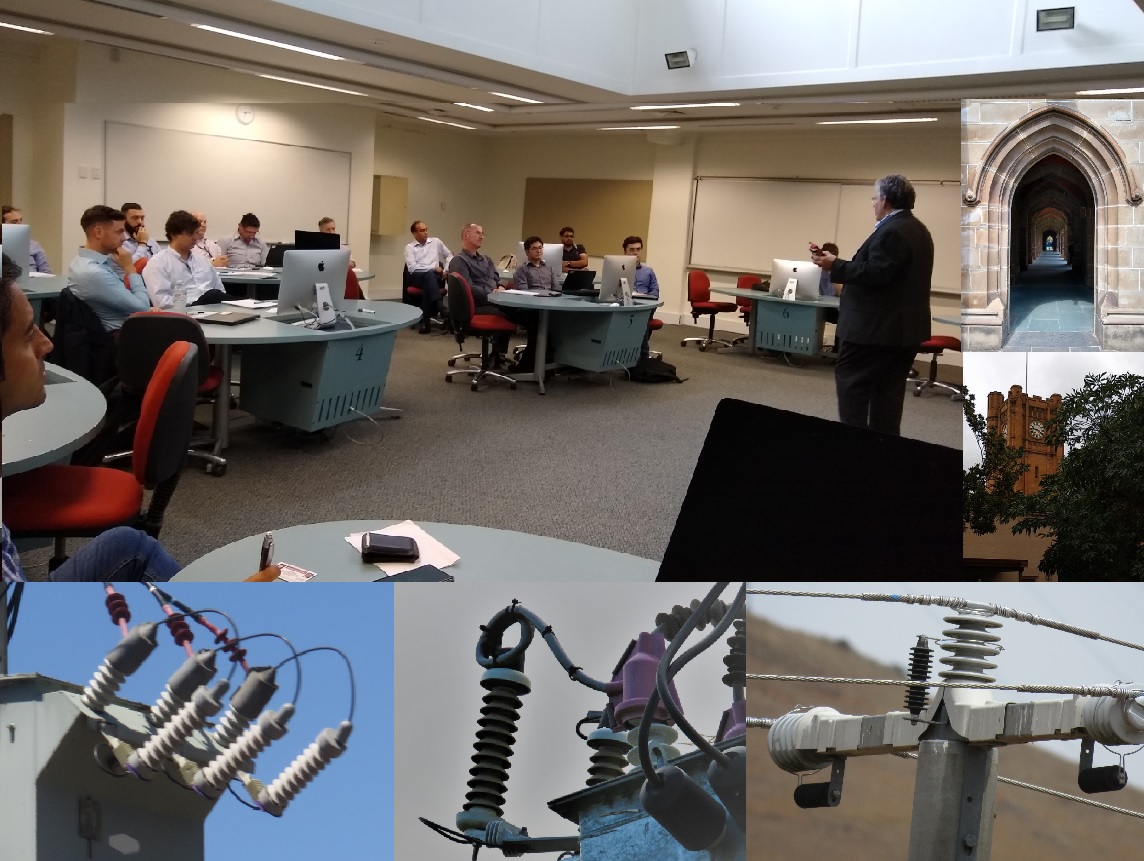
On a recent trip to Southeastern Australia, ArresterWorks was pleased to present a T&D surge protection seminar at the University of Melbourne,
Old Arts Building, Parkville VIC 3052, Australia. The seminar was sponsored by the IEEE Power Engineer Society, Victoria Section, with attendees from several
area utilities and consultancies.
Surge protection of power systems in Australia requires extra precautions when it comes to the use of arresters due to the increased risks of brush and forest fires. For
this reason, ArresterWorks was interested in observing how arresters were utilized in the cities versus the country as well as the different types of arresters used and
how they were applied. It was a very informative trip and ArresterWorks is grateful to everyone who helped in this learning experience.
Announcing March
T&D Surge Protection Webinar
Click here for details
IEC - 1906 Award
Recognizes exceptional current achievements of experts
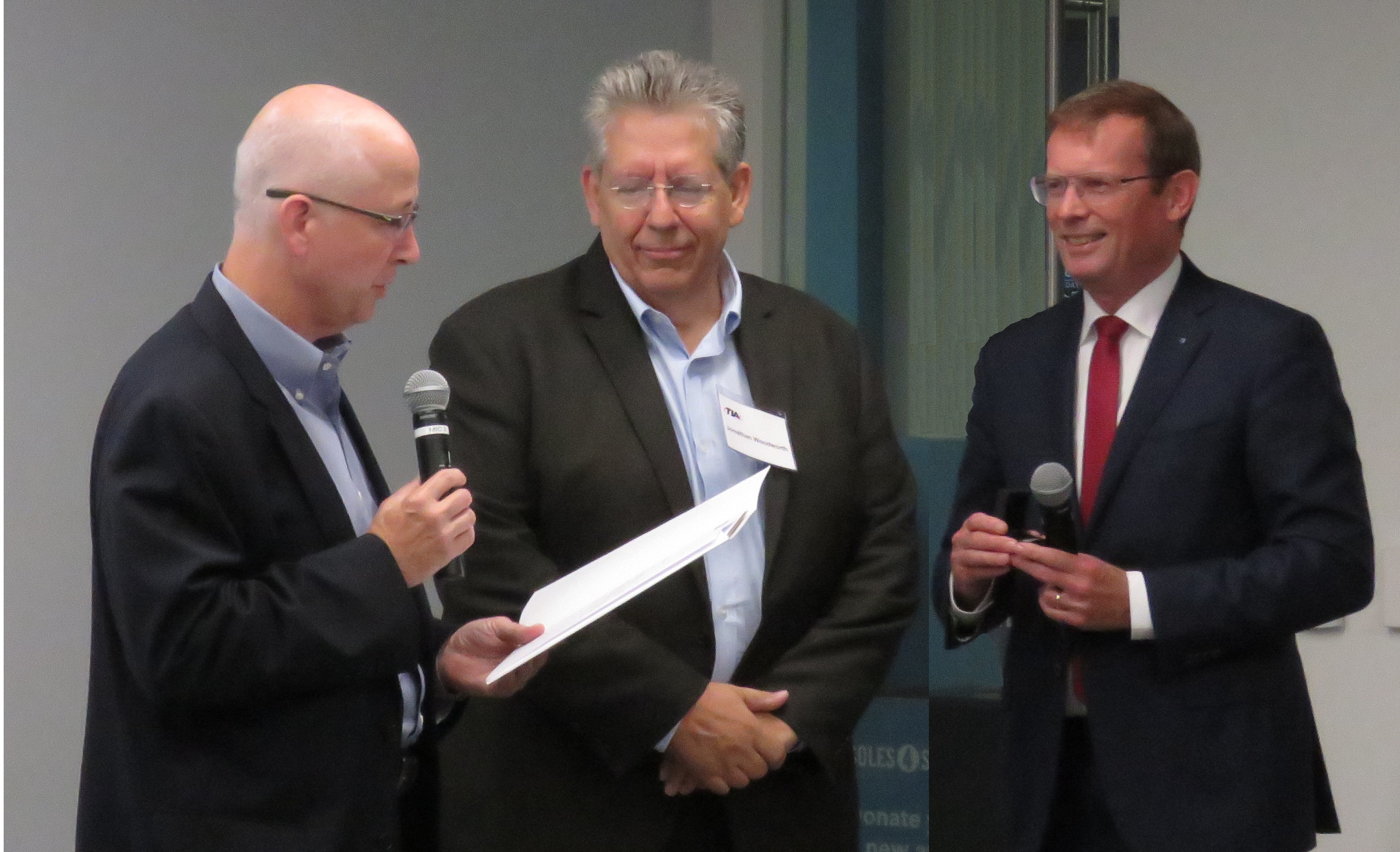
|

|
|
John Thompson (L) |
Jonathan Woodworth (C) |
Frans Vreeswijk (R) |
|
On September 13th of this year, ArresterWorks' Jonathan Woodworth received IEC's
1906 Award at a ceremony in Arlington, Va. Jonathan received the award for his role in TC37 working group MT4 leading the development of IEC standard 60099-4 Test Rationale and
spearheading the use of monthly virtual meetings. |
Onsite Training Offered By ArresterWorks
Sometime, the most economical way to train a number of your people is to bring the trainer to your facility. Recognizing this, ArresterWorks has created training sessions that are intended to be presented to a live class room. Each of these sessions can be tailored to meet the specific needs of the customer, covering only the material that is pertinent to the customer’s needs.
|
|
|
|
Seminar offerings: - - - - |
Substation overvoltage protection seminar Transmission line overvoltage protection seminar Distribution system overvoltage protection seminar Custom seminar base on customer requirements |
Click here for details
Announcing April - May 2018
Insulation Coordination Fundamentals Webinar
Click here for details
ArresterFacts Mini on the Marx Generator
A long history in arrester testing

Without question, the heart of surge arrester testing is the Marx generator. This high
impulse current or high impulse voltage generator is used to simulate lightning for
all the major impulse tests required by standards. Designed by Erwin Marx in Hermsdorf
Germany in 1924, it has changed very little in 94 years. The Marx generator is able to
produce such high currents and voltages by charging relatively low voltage capacitors in
parallel and then discharging them in series. Today, all these years later, every high
impulse voltage and current laboratory owns and operates one or two of these generators.
The generator shown in the photo above is an example of a high current Marx generator
and is from the Central Power Research Institute (CPRI) of India which has recently
upgraded their generator to obtain higher currents as well as their data acquisition system.
Announcing ArresterWorks' Online
Insulation Coordination Seminar
October 2017
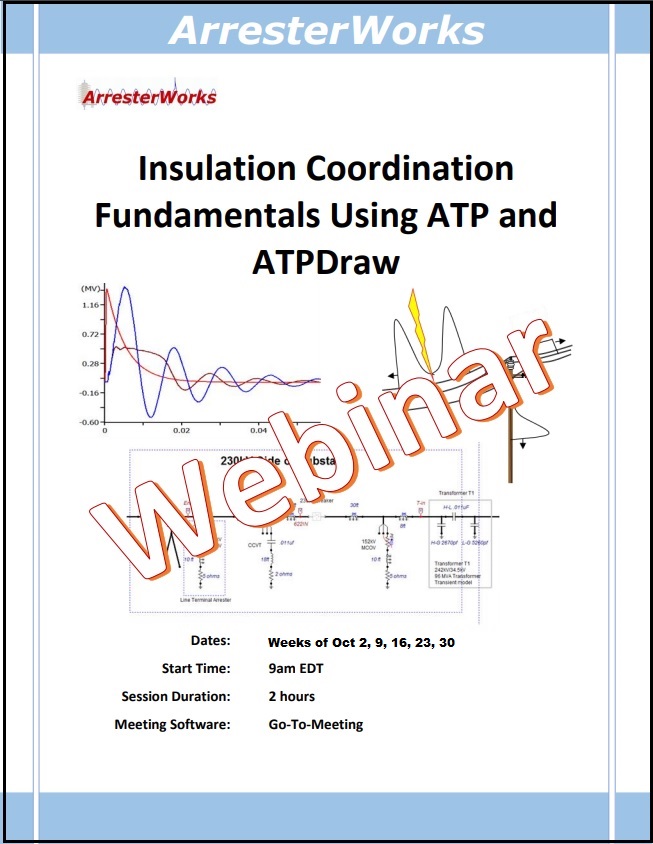
|
This seminar covers the fundamentals of insulation coordination as well as instruction on how to run transient
simulations. The seminar will be presented over a five-week period in two hour sessions. This schedule is intended
to allow time in between sessions to complete the provided exercises that will test the individuals understanding
of the covered information. |
|
Who Should Attend: Anyone who wishes to learn the fundamentals of Insulation Coordination Studies Fee: $699 PDH Credits: 10 credit hrs |
Recommended Prerequisites • Attendees should have working ATP, ATPDraw and XY-Plot packages installed on their computers. Or your own transient software package to run simulations on. • Fast Internet line that can handle video conferencing. • 2-3hour time slots once a week for 5 weeks. • Time to do homework between sessions. Link to Registration Page Link to course brochure and outline |
EGLAs in West Texas

|
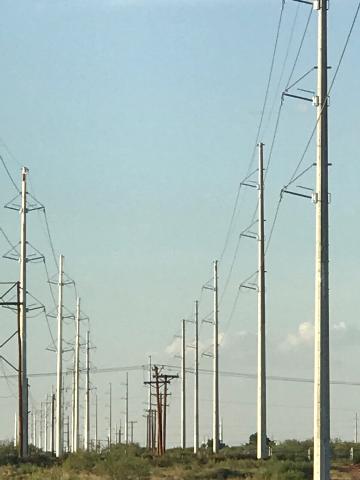
|
|
We have long felt that the externally gapped arrester is the most beneficial arrester to use on overhead transmission lines. In fact, we have published a number of papers supporting this idea. We were very pleased when we recently received these photos of ELGAs that have been installed on two lines just west of Andrews, Texas. We are interested in learning who designed or owns this installation, as well as who is the manufacturer of this arrester. If anyone has any information, please send us an email jonathan.woodworth@ArresterWorks.com. or give us a call (+1.716.307.2431). |
ArresterWorks - Arrester Thermal Profile Project
|
ArresterWorks is conducting a study on the correlation between arrester leakage current and its surface temperature. This is part of the work that will be presented at the 2017 INMR World Congress. We are using a wireless sensor (patent pending) attached to the outside of the 152kV MCOV polymer housed arrester for the data collection. One of the first things you learn about the surface temperature of an arrester is that it is always in flux. The many variables that affect its temperature will make this parameter very hard to model. In any case, here is a preview of the temperature of an arrester over a 5-day period. The arrester is not energized and all the variations come from the environment. More interesting results to come…... |
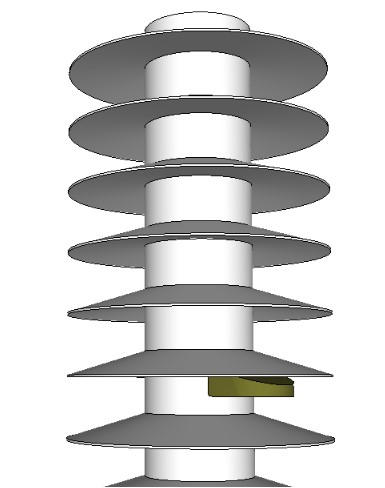
|

|
IEEE General Meeting

At the request of IEEE, ArresterWorks presented a one day Surge Protection Seminar at the 2017 IEEE general meeting in Chicago, Illinois.
Surge Protection Lecture at Florida State University
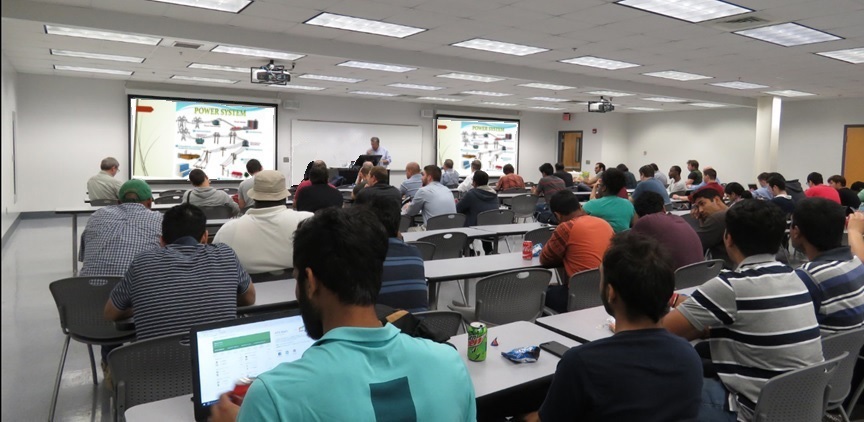
On Tuesday, March 28, 2017 ArresterWorks was honored to presented to 65 plus graduate students
of the FSU electrical engineering department. Jonathan Woodworth lectured on the effects of
lightning surges on power systems and methods of mitigating the damage to power equipment with arresters.
Jonathan was invited to speak at FSU by Dr. Thomas Bellarmine, Ph.D., P.E. as part of the IEEE Power and Energy Distinguished Lecturer Program.
CEATI Grounding and Lightning Fall Conference

“Grounding and lightning issues continue to be an important area of
development for the industry. New and better ways to design, construct and test grounding and lightning
systems are progressing in order to meet higher standards and changing industry demands. This conference
is an open forum for information exchange, technical presentations, and training. It will focus on seven
overarching themes that will discuss ideas and experiences for the benefit of the participants and industry
as a whole.” |
ArreseterFacts 017 Companion Video
Understanding BackFlash
Overview of IEC 60099-4
Energy Handling Tests -
ArresterFacts 033 R3
MOV Arrester AC Conduction Simulation Tool Demo
ArresterFacts 027 Arrester Reference Voltage
Re-release as Video
ArresterFacts 009 What is a Lightning Arrester
New Release
ArresterFacts 044 Gapped MOV Technology
June 2016
Surge Protection Seminar Scheduled for June 2016

ArresterWorks Presents
Surge Protection Seminar
June 23-24, 2016
Hosted by Siemens Energy
ArresterWorks' surge protection seminar is an in-depth course covering the different
types of arresters, their design fundamentals and their applications to protect power systems.
This course is designed to help all those who deal with surge protection and/or system reliability.
When: Thursday June 23rd full day and Friday June 24th half day April 2016
Are you sure your substation is protected from what might be coming down the line.
The assets in a substation can be worth millions. The surge protection of these assets is critical to
maintaining a healthy power delivery system. One way to ensure that all the necessary protection is
in place is to have an insulation coordination study of your substation. October 2015
Who Should Attend:
• Anyone new to the industry who wishes to learn the fundamentals of surge and lightning protection
• Standards engineers responsible for maintaining system construction and equipment standards
• Reliability engineers and other reliability personnel responsible for continuous improvement
• Substation designers, distribution system designers, and transmission line designers
• Power system operations and maintenance supervisors
• Power engineering personnel who wish to broaden their scope of system understanding
• Experienced engineers that want to learn about the latest energy ratings of arresters
Course Brochure
Where: Siemens Energy Inc, 444 Highway 49 South, Richland, MS
Fee: 899 USD
Contact: Deborah.Limburg@ArresterWorks.com. for questions.

ArresterWorks routinely does studies for utilities, wind farms, PV farms, transformer manufactures and EPC firms.
Visit our FAQ page on insulation coordination studies for more information .
Look for our ArresterFacts on this topic coming in May. In the mean time we invite you to call or email us with any additional questions you might have or if we can be of service.

On October 18 – 21, over 600 attendees from 60 countries came to Munich Germany, for the 2015 INMR World
Congress. This year’s congress marked 20 years of INMR bringing the world together for discussions on
insulator, arresters, bushings, and cable accessories.

The arrester session, a relatively new addition to the congress, was co-chaired by Jonathan Woodworth of
ArresterWorks and Professor Hinrichsen of TU Darmstadt. The session consisted of eighteen papers covering
topics of importance to both the manufacturers and the users of surge protective devices. Talks included
discussion on arrester monitoring devices, IEC standards, voltage distribution along an arrester, and
arresters of the future.
Jonathan Woodworth presented a paper entitled "Arrester 2050". The subject matter was a call to the arrester
world for a paradigm shift in surge protection. He emphasized that the introduction of polymer housed arrester
in the 1980’s was the last major change in the arrester industry. Mr. Woodworth stated that he envisions arrester
2050 being lighter, greener, self-installing and much smaller than today. He continued by stating that with
improved MOV characteristics, the arrester 2050 may not even resemble arresters as we know them. Although he
made light of these futuristic changes, the underlying message was a serious one in that the arrester designers of
the future will have to let go of the boundaries of today if they want to be the innovators of tomorrow.
Read Arrester 2050 paper.
August 2015
Standards Update December 2014
As of this past May, the IEC and IEEE High Voltage Surge Arrester Committees have
initiated a Harmonization Task force. We will be meeting 2 times per year for the
next few years with the goal of harmonizing C62.11 and IEC 60099-4. At the present
time there are several sections that were written with harmonization in mind and it
has worked quite well. There are about 5 or more sections in the design tests that
can be unified and harmonized. Our first tasks are to identify these sections and
start the process of making them as similar as possible if not identical. More info
in early November on how it is going.
New IEC Arrester Standard Published This Year As shown in the table below, Station Class arresters will have a Qrs and Wth rating.
Distribution arresters will have a Qrs and Qth rating. October 2014
60099-4 Ed. 3.0 - 2014: Surge arresters - Part 4:
Metal-oxide surge arresters without gaps for a.c. systems
A new concept of arrester classification and energy withstand testing is introduced: the line discharge
classification is replaced by a classification based on repetitive charge transfer rating Qrs, thermal
energy rating Withzz and thermal charge transfer rating Qth, respectively. The new concept clearly differentiates
between impulse and thermal energy handling capability, which is reflected in the test procedures and minimum pass criteria.
The Definitions of these ratings are as follows:
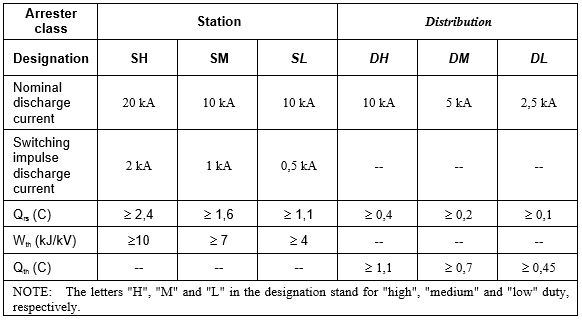
The newest version of the publication can be purchased at the IEC Web Store.
IEC MT4 and MT10 Fall Meeting attended
by delegates from 7 Countries
This year's fall IEC MT4 and MT10 meetings were held in Niagara Falls Canada.
Eighteen maintenance team members travelled from around the world to attend the meetings.
The focus of the meets were on the next editions of IEC 60099-4, 60099-5, 60099-6 and 60099-8. All standards
will be published in the next 3 years. A Technical Report that will likely have the Designation 60099-10 is also in the
works and will contain all the rationale of required tests. This will be a first for the IEC and should add significant
value to our work.
A special thanks to this years sponsors:
NEMA
Eaton's Cooper Power Systems
Hubble Power Systems
IEEE SPDC Fall Meeting held in Clearwater, Florida
September 2014
In 2012 the last edition of IEEE C62.11 was published. One of the main objective of the meetings in Clearwater
was to work on the next edition. The new release will include new sections related to transmission line arresters
as well as streamlined sections related to all other arresters. Target publication is 2018
ArresterNews Features INMR 2015 World Congress Call for Papers and New ArresterFacts
June/July 2014
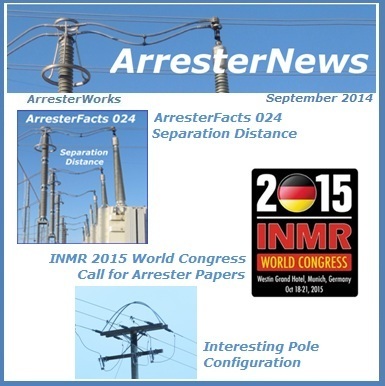
Articles Inside
1. ArresterFacts 024 - Separation Distance
2. INMR 2015 World Congress Call for Papers
3. Photos of Interest: Interesting Configuration
Online version of September ArresterNews
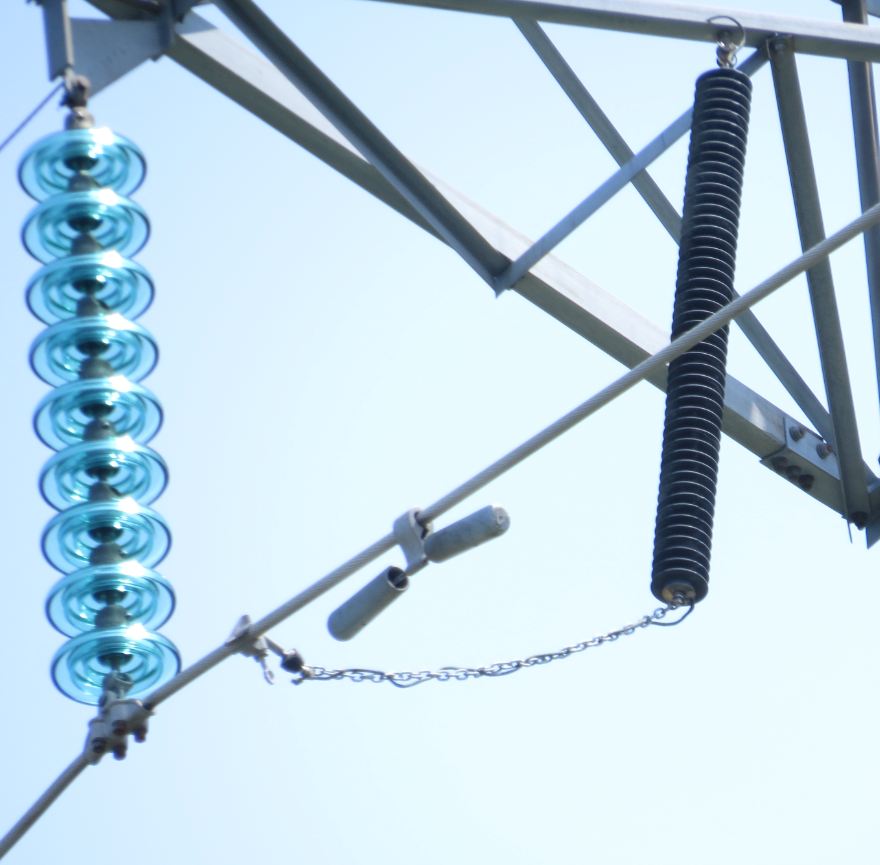
ArresterWorks visits Maritime Electric and NB Power
During the months of June and July, ArresterWorks visited New Brunswick Power and Maritime Electric to present Overvoltage Protection seminars.
In both seminars the participants brought real world surge protection issues to the table for discussion, enhancing the value of the seminar.
We were pleased to receive the following comment from Shelly Feltmate, Senior Engineer – Transmission Lines, at New Brunswick Power:
"The ArresterWorks – Overvoltage Protection Seminar was by far one of the most informative and interesting seminars I have attended to date.
By keeping the seminar extremely interactive with the attendees, the material covered was easily tailored to our experiences and/or interests as a company."
Also as part of this trip we surveyed the New Brunswick and Prince Edward Island Provinces documenting and photographing the different methods
of lightning protection of the power systems.
June 2014

ArresterWorks to develop guide for the condition assessment of lightning arresters installed on transmission lines
for CEATI International (www.ceati.com )
Arresters have been protecting power lines in substation and on distribution lines for more than a century.
Despite this long history, it has only been in the last 20 years that arresters have begun to be used on
sub-transmission and transmission lines. This relatively new application of the arrester has left many users
questioning how to verify the health of the arresters they have in service. At present, there are no comprehensive
guides for the maintenance of arresters on transmission lines; however, this problem will soon be resolved.
CEATI International has retained ArresterWorks to write a transmission line arrester guide that will cover both the electrical
and the mechanical maintenance aspects. The primary objective of this project will be to produce a guide that
clearly shows how to use existing arrester condition assessment tools on transmission line arresters.
The guide will assist CEATI Transmission Line Asset Management group members in understanding the health and the expected remaining life of their
arresters, with focus on assessment methods currently available for both Non-Gapped Line Arresters (NGLA) and
Externally Gapped Line Arresters (EGLA).
May 2014

ArresterWorks granted its first arrester patent.
On April 29, 2014 ArresterWorks was granted US Patent No. 8,711,538 for an EGLA failure indicator.
This device now makes the EGLA a more desirable arrester for line protection in that not only does
it restore the original system BIL if the arrester should fail, but it also provides a visual
indication that the arrester has failed.
April 2014

The 2014 IEEE PES T&D Conference & Exposition brought hundreds of manufactures and users
together in Chicago. On display were a number of arresters in various applications.
Click here to view photos from the exposition.
Besides the exposition there was a variety of technical papers presented. The Lightning Performance
of Overhead Lines panel session was comprised of four informative presentations. Among them was a
presentation by ArresterWorks', Jonathan Woodworth on Externally Gapped Line Arresters - A Critical
Design Review
March 2014
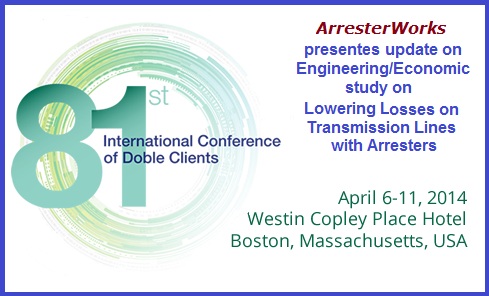
ArresterWorks' Jonathan Woodworth presented an
update on engineering/economic study on lowering losses of
transmission lines with arresters at the Doble International
Conference in Boston, Massachusetts.
Power systems experience losses in many forms and a great deal
of effort is put forth to reduce these losses in many areas.
However the losses related to overhead ground wires (OHGW) of
transmission lines arerarely mitigated on systems below 345kV.
The losses relating to OHGWs are due to inductive currents from
the phase conductors onto the OHGW or sometimes called shield
wires. The study showed how arresters can be used in place of
OHGWs on transmission lines to 100% eliminate induced
losses and at the same time increase the reliability of the
system.
The study was funded in part by NYSERDA and was
conducted in cooperation with ArresterWorks, Ceralink Inc,
Rensselaer University and Cornell University.
September 2013

Vancouver's sunny days were the perfect backdrop for
INMR's 2013 World Congress
People involved in surge protection, from around the world, came to Vancouver to attended the congress.
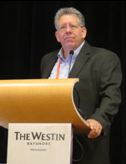
ArresterWorks' Jonathan Woodworth, session chair and co-organizer of the Congress Arrester Session,
presented an engineering/economic study on lowering losses of transmission lines with arresters.
The study, which is being funded in part by NYSERDA, is still in process and is being conducted in
cooperation with ArresterWorks, Ceralink Inc, Rensselaer University and Cornell University.
More information on the project will be available in the future as it advances.
August 2013

ArresterWorks holds sucessful
Overvoltage Protection Seminar
in cooperation with
Duke Energy
Charlotte, NC
July 2013
June/July ArresterNews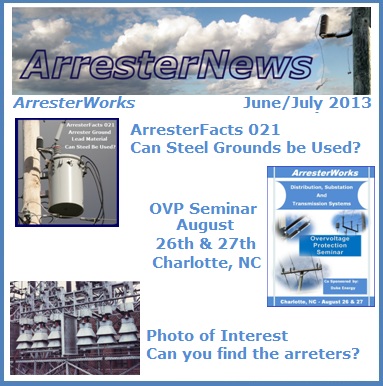
Articles Inside
1. ArresterFacts 021 - Arrester Ground Lead Material
Can Steel be Used
2. August OVP Seminar - ArresterWorks
Cosponsored by Duke Energy
3. Photos of Interest - Find the Arrester
May 2013
May ArresterNews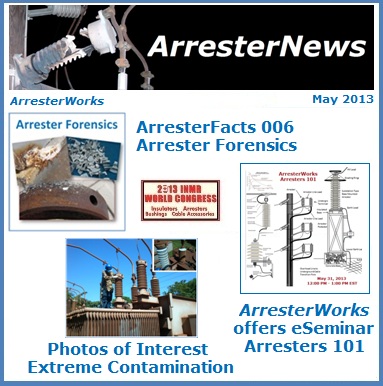
Articles Inside
1. ArresterFacts 006 - Arrester Forensics
2. eSeminar - Arresters 101
3. Photos of Interest - Extreme Contamination
Online version of May ArresterNews
April 2013
Insulation Coordination FAQA quick overview of Insulation Coordination for Power Systems

Overview
This is a quick overview of the complex subject of Insulation Coordination. It contains links to example studies and ArreterFacts 037 on the same subject.
New FAQ Page on Line
Down Load the FAQ
April 2013 ArresterNews

Articles Inside
1. Insulaiton Coordination FAQ
2. A Unique Application of Power Conductors
3. Survey: Do you experience pole damage from Lightning?
Online version of April ArresterNews
New Photos on Pole Damage Posted
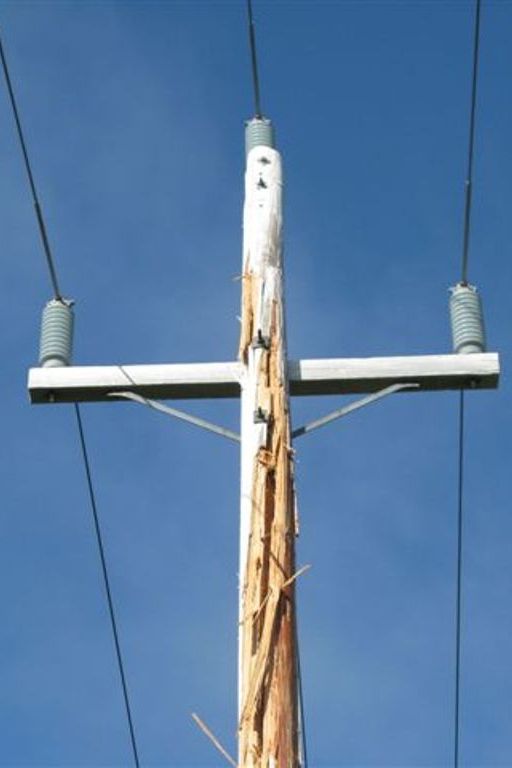
Check out these examples of pole damage. If you have experienced such damage, let us know.
Go to Photo Page
March 2013
ArresterFacts 042
Guide for Selecting an Arrester Field Test Method

Overview
This ArresterFacts offers guidance when selecting the method to test surge arresters away from the lab environment
ArresterFacts 042 - Guide for Selecting an Arrester Field Test Method
Extreme Arresters
A Collection of Arrester Photos at Extreme Locations

This first of the series Extrene Arrester Photos comes from West Quoddy Head, Maine, USA. Where the eastern
most surge arrester in the Continental USA is located. Have a look.
Extreme Arresters Photo Page
New Forum Post
To Add An Extra Ground or Not, That is the Question

ArresterWorks has posed the question as to whether a parallel conductor is necessary for an arrester that
is mounted on a transformer structure that is also grounded to the station grid.
Take a look at the complete question and photo.
Januray 2013
ArresterFacts 032
The Sheath Voltage Limiter

Overview
The ArresterFacts covers all aspects of Sheath voltage limiters including how to select the MCOV rating is now available.
ArresterFacts 032 - The Sheath Voltage Limiter
For those using ATPDraw to model Sheath Voltage Limters, there are two models that can be downloaded here.
SVL and Cable Model for Lightning Analysis for ATPDraw (.acp file zipped)
SVL and Cable Model for Switching Analysis for ATPDraw (.acp file zipped)
Donald E Raudabaugh
Inducted into Surge Protection Hall of Fame
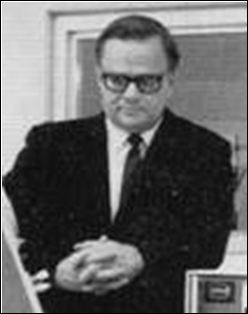
Donald E Raudabaugh is credited with initiating the "Polymer Housed Arrester Era" of surge arresters. In 1984 he
applied for the first patent that lead to the introduction of the polymer housed arrester in 1986 by the
Ohio Brass Company.
Complete Hall of Fame Citation
Hall of Fame Page
October 2012
No Ordinary Call for Papers2013 INMR World Congress
 In September of next year ArresterWorks will be at the 2013 INMR World Congress and there is no doubt it will be an exciting time.
If you have been involved in an interesting surge protection issue that is being or has been resolved, the world wants to hear your story.
This is an opportunity of a career, to tell other like minded people what you have done and how you succeeded.
We are looking for papers and presenters. If you are interested, click here and let me know.
In September of next year ArresterWorks will be at the 2013 INMR World Congress and there is no doubt it will be an exciting time.
If you have been involved in an interesting surge protection issue that is being or has been resolved, the world wants to hear your story.
This is an opportunity of a career, to tell other like minded people what you have done and how you succeeded.
We are looking for papers and presenters. If you are interested, click here and let me know.
ArresterFacts 040
New IEEE C62.11 Arrester Test Requirements

Overview
In just a few weeks, the 2012 edition of IEEE C62.11 will be published. This new test standard is a dramatic improvement over the last edition in that it contains for the first time standardized energy handling tests.
ArresterFacts 040 - The New IEEE C62.11 Test Requirements (An Overview)
September 2012
ArresterFacts 038
Calculating Value of a Distribution Arrester?

Overview
This ArresterFacts presents a new method of calculating the value of an arrester. In this evaluation, the arrester value is equal to the cost of equipment that would have to be replaced if the arrester was not present. A calculator is also on the Calculator Page that allows for a check of arresters in your area of interest.
ArresterFacts 038 - Calculating the Value of a Distribution Arrester
ArresterWorks' First Online Calculator...
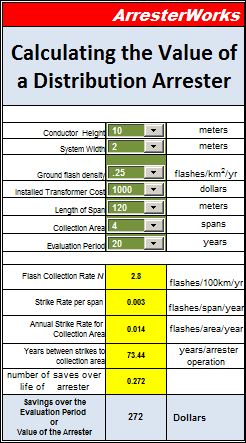
This on-line calculator can be used to check the value of your arrester.... Give it a try
On-line Distribution Arrester Value Calculator
ArresterFacts 033 Updated
An Overview of Proposed Energy Handling Tests in IEC 60099-4
 Later this year a significant change in the way arresters are rated relative to energy handling will
become a standard. This ArresterFacts provides an overview of what is coming. Anyone that specifies, tests,
manufacturers, or uses arresters should put reading this on their to-do-list.
Later this year a significant change in the way arresters are rated relative to energy handling will
become a standard. This ArresterFacts provides an overview of what is coming. Anyone that specifies, tests,
manufacturers, or uses arresters should put reading this on their to-do-list.
Visit the ArresterFacts Library
August 2012
ArresterFacts 029
Distribution System Responses to Lightning

Topics Covered
1. Current and Voltage Distribution on a Line after a Strike
2. Arrester Behavior on a Line
3. Arrester Spacing Effects
If you have ever wondered how often to apply arresters on a line to reduce outages, this Arresterfacts is for you.
ArresterFacts 029 Distribution System Responses to Lightning Strikes
July 2012
ArresterFacts 028 "Understanding TOV Behavior of Arresters"Published in Australiain Transmission & Distribution eMag June-July 2012

How an arrester responds to power frequency temporary overvoltages (TOV), is seldom discussed in the literature and a phenomenon that is studied even less. This Arresterfacts is a short synopsis of the topic that should introduce the reader to some of the aspects of TOV with respect to arresters -Check it out-
June 2012
ArresterFacts 037
Insulation Coordination Fundamentals

Topics Covered
1. Basic Insulation Coordination Definitions
2. Surge Characterstics
3. Insulation Characteristics
4. 2% Voltage Overview
5. Distribution System Insulation Coordination
Insulation Coordination Fundamentals - Where Arrester and Insulator Characteristics Meet -
AutoGap Arrester by Hubbard added
to ArresterWorks Virtual Museum
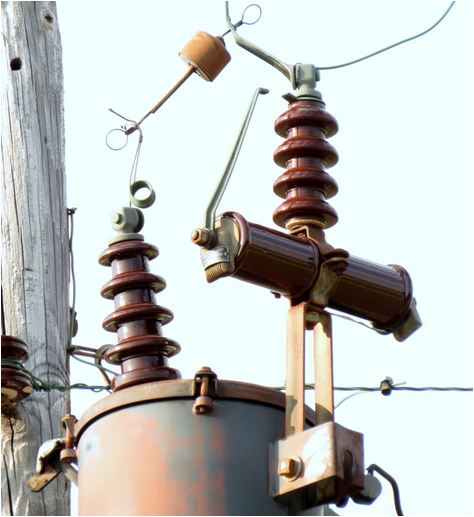 This Hubbard AutoGap Arrester has been protecting its transformer for
for perhaps 60 years. Hubbard an arrester manufacturer introduced this
arrester in 1952 and proclaimed better protection because it had
two vents for expulsion of the arc by-products.
This Hubbard AutoGap Arrester has been protecting its transformer for
for perhaps 60 years. Hubbard an arrester manufacturer introduced this
arrester in 1952 and proclaimed better protection because it had
two vents for expulsion of the arc by-products.
-Have a look-
April 2012
ArresterWorks Introduces eConsulting in Surge Protection
A Rapid Response Engineering Service
 For the organization that needs expert help on a surge protection issue
Right Now and you prefer not to initiate a long term high cost project.
You just want to solve this issue and move on. Using everyday video and
internet technologies, you can do it with eConsulting at ArresterWorks.
Check out the
eConsulting Service.
For the organization that needs expert help on a surge protection issue
Right Now and you prefer not to initiate a long term high cost project.
You just want to solve this issue and move on. Using everyday video and
internet technologies, you can do it with eConsulting at ArresterWorks.
Check out the
eConsulting Service.
ArresterFacts 036
Arrester Condition Monitors - A State of the Art Review
 Topics Covered
Topics Covered
1. Purpose of Arrester Condition Monitoring
2. Surge Counters
3. AC Leakage Current Meter
4. Third Harmonic Current Measurement
5. Partial Discharge Detection
6. Thermal Imaging
7. Off Line Arrester Field Testing
Arrester Condition Monitoring - A State of the Art Review -
eSeminar - Arresters 101 now available
for Group Lunch and Learn Type Presentations (on line)
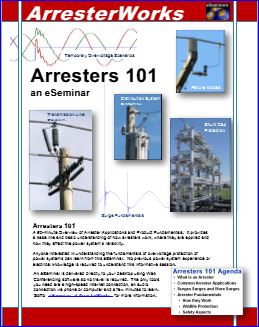 If you have a group that could use a better understanding of Arresters.
Taka advantage of his free offer. ArresterWorks will do an eSeminar on Arresters based on your schedule.
Conatact us for scheduling. Remember this qualifies for CEU credits.
If you have a group that could use a better understanding of Arresters.
Taka advantage of his free offer. ArresterWorks will do an eSeminar on Arresters based on your schedule.
Conatact us for scheduling. Remember this qualifies for CEU credits.
Click here for Brochure on Arresters 101
February 2012
ArresterWorks Introduces eSeminar Series
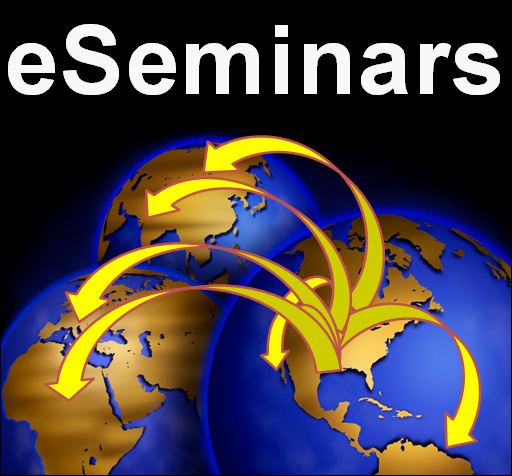 ArresterWorks has made learning about surge protection of power system easier and more cost effective than ever.
Our new eSeminar series allows participants to eliminate travel costs and wasted time, by just
participating in an online dialog on many surge protection subjects. Check out the
eSeminar Series.
ArresterWorks has made learning about surge protection of power system easier and more cost effective than ever.
Our new eSeminar series allows participants to eliminate travel costs and wasted time, by just
participating in an online dialog on many surge protection subjects. Check out the
eSeminar Series.
ArresterFacts 034
Conductor Size Considerations for Staton Class Arresters
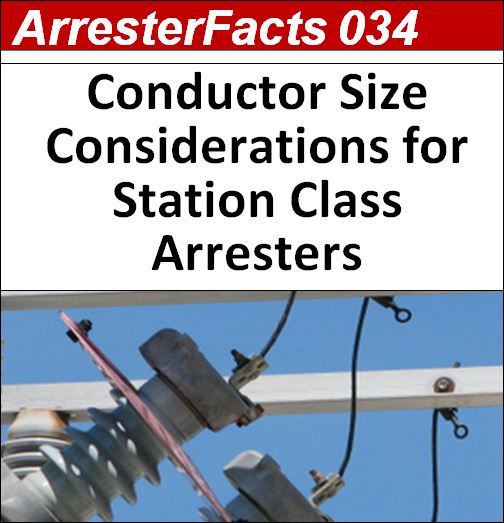 Topics Covered
Topics Covered
1. Diameter and Length Effects
2. Fault Current Considerations
3. Corona Considerations
4. Effect on Voltage Refelections
5. Mechanical Considerations
6. Ground Conductor Considerations
Conductor Size Considerations for Station Class Arresters
ArresterFacts 017a
Transmission Line Arrester Selectiion Guide
 Topics Covered
Topics Covered
1. How to determine the MCOV/Uc
2. How to select the Energy Rating
3. How to determine the Margin of Protection
4. The importance of Failure Mode
5. Mounting options overview
Transmission Line Arrester Selection Guide
What Constitutes an Arrester Failure?
 Do you ever wrestle with the notion of what is a failure when it comes to arresters. This Facebook post discusses the subject a
bit. Take the survey and send me the results.
Do you ever wrestle with the notion of what is a failure when it comes to arresters. This Facebook post discusses the subject a
bit. Take the survey and send me the results.
ArresterWorks on FaceBook
 To make it easier for all you younger folks that use Facebook all the time, we now have a FB Page as a business...With Facebook
at 850 million users, how can we go wrong.........Enjoy
To make it easier for all you younger folks that use Facebook all the time, we now have a FB Page as a business...With Facebook
at 850 million users, how can we go wrong.........Enjoy
Januray 2012
1988 Varistor Conference
 In 1988 the Second and last International Varistor Conference was held in the US. An excellent
photo of the attendees exists, however there is no identifying index for the attendees. Can you Identify anyone,
if so, please let me know who. The lists and photos are in the History Article section
Full photo of Conference
List of Attendees
List of Identified Attendees
In 1988 the Second and last International Varistor Conference was held in the US. An excellent
photo of the attendees exists, however there is no identifying index for the attendees. Can you Identify anyone,
if so, please let me know who. The lists and photos are in the History Article section
Full photo of Conference
List of Attendees
List of Identified Attendees
Have a look on History Article Page
David W Jackson Inducted into Surge Protection Hall of Fame
 Dave W Jackson's career spanned 61 years. The entire time he was involved in power system
design and applicaitons. He became involved in Surge Protection in 1960 and remained
active in standards until 2007. Complete Hall of Fame Citation
Dave W Jackson's career spanned 61 years. The entire time he was involved in power system
design and applicaitons. He became involved in Surge Protection in 1960 and remained
active in standards until 2007. Complete Hall of Fame Citation
Hall of Fame Page
Prof Hinrichsen Elected Chairman of TC37
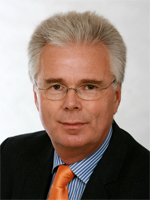 Professor Volker Hinrichsen has been elected Chairman of TC37 the Arrester Technical Committee of the IEC.
Prof Hinrichsen replaces Michele De Nigris who has fulfilled that function since 1990. Prof. Hinrichsen started
participating in IEC standards in 1992 and has been co-convenor of IEC TC37 MT4 since 2002 where he has repeatedly
demonstrated excellent leadership. Arrester Standards Page
Professor Volker Hinrichsen has been elected Chairman of TC37 the Arrester Technical Committee of the IEC.
Prof Hinrichsen replaces Michele De Nigris who has fulfilled that function since 1990. Prof. Hinrichsen started
participating in IEC standards in 1992 and has been co-convenor of IEC TC37 MT4 since 2002 where he has repeatedly
demonstrated excellent leadership. Arrester Standards Page
History of Arresters Used on Power Systems in the US
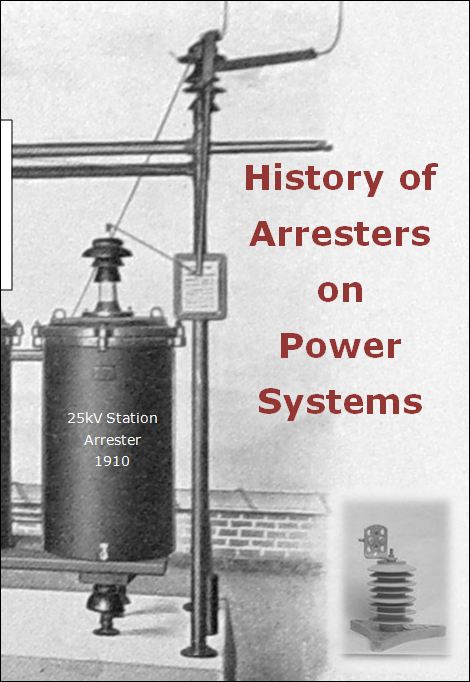 For the first time, a complete history of surge arrester used on power systems
has been published. This history takes you from the first lightning protection devices to the latest
polymner housed arresters of today.
For the first time, a complete history of surge arrester used on power systems
has been published. This history takes you from the first lightning protection devices to the latest
polymner housed arresters of today.
US History of Arresters 1750-1890
US History of Arresters 1890-1930
US History of Arresters 1930-1965
US History of Arresters 1965-Present
December 2011
Created the ArresterWorks Virtual Museum
 After years of procrastination, I have finally posted the beginings of our Arrester Museum (Virtual Style).
The first exhibit is from a 1925-30 vintage Pellet Type arrester from GE.
This is only the first of many exhibit postings. We hope to make
this a collaborative effort of those that have photos of old arresters and are willing to share them.
ArresterWorks will also gladly take donations of old arresters for our
Museum and for the display in the virtual museum. Enjoy.....
After years of procrastination, I have finally posted the beginings of our Arrester Museum (Virtual Style).
The first exhibit is from a 1925-30 vintage Pellet Type arrester from GE.
This is only the first of many exhibit postings. We hope to make
this a collaborative effort of those that have photos of old arresters and are willing to share them.
ArresterWorks will also gladly take donations of old arresters for our
Museum and for the display in the virtual museum. Enjoy.....
-Have a look-
November 2011
CEATI Grounding and Lightning Workship Presentation
I was an invited speaker at the CEATI Grounding and Lightning Workshop to discuss applicaitons on Externally Gapped Line Arresters (EGLA).
-Have a look-
October 2011
Attended IEC TC37 MT4 and MT10 Arrester Standards Meetings
IEC Test Standard 60099-4 and Application Guide 60099-5 are very close to re-issue. The meetings were to discuss the latest editions. 60099-4 will publish its first CD in January. 60099-5 will publish an FDIS in January. Both documents are major upgrads to the previous documents.
Attended IEEE SPD Arrester Standards Meetings
IEEE C62.11 in very close to a new edition that has major improvemements in energy handling tests and methods. This document will be ballotted in the first part of 2012 and should be published in late 2012.
August 2011
Lightning Protection of Power Systems - Then and Now - Part 1
Finally I have found the time to start my Lightning Protection History Article, which I have been wanting to do for 5 or more years. It is coming in three installments over the next 3 months. Thanks goes to Waymon Goch of Classic Connectors Inc for giving me the encouragement to write it. -Have a look-
Updated Project List
ArresterWorks isn't only the Best Surge Proteciton Website on the Net, it is First and Formost an International Consultancy focused on Surge Protecton of Power Systems. We have updated our project list to show the type of projects we are engaged in. -Have a look-
Two New ArresterFacts
ArresterFacts 028
Understanding Arrester TOV Responses
How an arrester responds to power frequency temporary overvoltages (TOV), is seldom discussed in the literature and a phenomenon that is studied even less. This Arresterfacts is a short synopsis of the topic that should introduce the reader to some of the aspects of TOV with respect to arresters -Check it out-
ArresterFacts 030
Modeling Temperature Rise of Arresters from Energy Absorption
This ArresterFacts explains how to predict the temperature rise in an arrester using hand calculations, Excel spread sheet, and ATP models. Several support documents are also availble on the ArresterFacts page including the ATP models. Enjoy -Check it out-
July 2011
Lightning Study
Completed a Lightning Study on a 138kV transmission line in Eastern US.
After modeling the system in detail, it was concluded that the lines could not be flashing over due to lightning strikes to the shield. Further investigation revealed that the lines were experiencing a shield failure due to construciton over terrain sloping away from the lines. " Arresters to the rescue!!! "
VI Characteristic Curve
Published an Excel based App to generate the Voltage-Current Characteristic curve of any arrester desired. It can be used in Modeling Arresters in ATPDraw.
- Check it out -
Arrester Temperature Rise Calculator
Published a second Excel based App that assists transient study experts in modeling the tempreature rise of an arrester after energy absorption.
- Check it out -
June 2011
Forum Entry on Marx Generator
See my latest entry in the ArresterWorks forum regarding Marx Generators and A Marx Generator ATP Model can be downloaded here.
Published two new ArresterFacts:
ArresterFacts 026 Measuring Discharge Voltage on Fast Rising Surges discusses for the first time, the new methods that will be specified in IEEE C62.11 when published in 2013. It also describes how the data shall be published in both IEEE and IEC literature.
ArresterFacts 027 Reference Voltage is all about the important arrester characteristics Vref that is docummented almost nowhere. This is the most comprehensive treaties of this subject published todate.
May 2011
Arrester Standards Development
Attended both IEC and IEEE Arrester Standards Meetings. There is more going on in these two meetings today than there has been in a long time. Both standards writing groups are producing new test standards and will both publish in 2013. Significant changes in energy and charge transfer withstand will be included in the 2013 edtions.
April 2011
INMR World Congress in Seoul
Chaired the Arrester Session at the 2011 INMR World Congress Seoul South Korea Ten Excellent papers were presented by distinguished industry experts. Bill Chisholm a Canadian Consultant discussed special icing issues relative to line arresters, Plamen Bunov from Siemens presented results of recent tests conducted on the externally gapped arrester, Hans Ove Kristiansen from Doble, offered an interesting overview test methods for monitoring arrester health, Frederic Malpiece of Tridelta France, provided insights into the new energy handling tests as well as offered an overview of MOV disk manufactring, Georgij Podporkin of Streamer Inc, introduced the latest model of line protection arresters based on the multi-chamber concept, Hakan Westerlund from ABB presented an intersting overview of arrester monitoring options and offered an excellent overview of third harmonic measurements, Lars Klingbiel of Siemens presented the latest design details of the ACM, the newest arrester monitor on the market.
February 2011
New ArresterFacts
Published ArresterFacts 025 on Deadfront and Separable Arresters This latest ArresterFacts gives you the basics of the arrester plus shows why it is such an important part of surge protection in underground circuits. Clear plots are shown that demonstrate the voltage doubling effect and how it is mitigated with arresters at or near the open point . Download PDF . View online
December 2010
Surge Protection Seminar By ArresterWorks
March 2011
Orlando, Florida
New Topics
- Modeling Transmission Lines with ATP
- Overview of Latest IEC and IEEE Energy Tests
November 2010
IEC Standards Meeting: Berlin Germany There is a significant number of changes in the works on IEC 60099-4. In 2012 when this becomes a published standard, there will be very positive improvements in the way arresters are tested and evaluated. More
October 2010
The 2010 North American Arrester Market and Product Report Now Available for Purchase

Send Email to Jonathan.Woodworth@arresterworks.com
for pricing, table of contents, and delivery options.
September 2010
Participated in CEATI Conference
The Lightning and Grounding Committee of CEATI sponsored an excellent workshop on the same subject. ArresterWorks was the Featured workshop for the event.
Ways ArresterWorks can be of service to you:
If you are a ManufacturerIf you are a Utility or Arrester User
If you are an Educator
